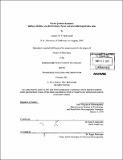Marine particle dynamics : sinking velocities, size distributions, fluxes, and microbial degradation rates
Author(s)
McDonnell, Andrew M. P
DownloadFull printable version (20.83Mb)
Other Contributors
Woods Hole Oceanographic Institution.
Advisor
Ken 0. Buesseler.
Terms of use
Metadata
Show full item recordAbstract
The sinking flux of particulate matter into the ocean interior is an oceanographic phenomenon that fuels much of the metabolic demand of the subsurface ocean and affects the distribution of carbon and other elements throughout the biosphere. In this thesis, I use a new suite of observations to study the dynamics of marine particulate matter at the contrasting sites of the subtropical Sargasso Sea near Bermuda and the waters above the continental shelf of the Western Antarctic Peninsula (WAP). An underwater digital camera system was employed to capture images of particles in the water column. The subsequent analysis of these images allowed for the determination of the particle concentration size distribution at high spatial, depth, and temporal resolutions. Drifting sediment traps were also deployed to assess both the bulk particle flux and determine the size distribution of the particle flux via image analysis of particles collected in polyacrylamide gel traps. The size distribution of the particle concentration and flux were then compared to calculate the average sinking velocity as a function of particle size. I found that the average sinking velocities of particles ranged from about 10-200 m d- and exhibited large variability with respect to location, depth, and date. Particles in the Sargasso Sea, which consisted primarily of small heterogeneous marine snow aggregates, sank more slowly than the rapidly sinking krill fecal pellets and diatom aggregates of the WAP. Moreover, the average sinking velocity did not follow a pattern of increasing velocities for the larger particles, a result contrary to what would be predicted from a simple formulation of Stokes' Law. At each location, I derived a best-fit fractal correlation between the flux size distribution and the total carbon flux. The use of this relationship and the computed average sinking velocities enabled the estimation of particle flux from measurements of the particle concentration size distribution. This approach offers greatly improved spatial and temporal resolution when compared to traditional sediment trap methods for measuring the downward flux of particulate matter. Finally, I deployed specialized in situ incubation chambers to assess the respiration rates of microbes attached to sinking particles. I found that at Bermuda, the carbon specific remineralization rate of sinking particulate matter ranged from 0.2 to 1.1 d', while along the WAP, these rates were very slow and below the detection limit of the instruments. The high microbial respiration rates and slow sinking velocities in the Sargasso Sea resulted in the strong attenuation of the flux with respect to depth, whereas the rapid sinking velocities and slow microbial degradation rates of the WAP resulted in nearly constant fluxes with respect to depth.
Description
Thesis (Ph. D.)--Joint Program in Oceanography (Massachusetts Institute of Technology, Dept. of Earth, Atmospheric, and Planetary Sciences; and the Woods Hole Oceanographic Institution), 2011. Cataloged from PDF version of thesis. Includes bibliographical references.
Date issued
2011Department
Joint Program in Oceanography; Woods Hole Oceanographic Institution; Massachusetts Institute of Technology. Department of Earth, Atmospheric, and Planetary SciencesPublisher
Massachusetts Institute of Technology
Keywords
Joint Program in Oceanography., Earth, Atmospheric, and Planetary Sciences., Woods Hole Oceanographic Institution.